Schedule
Talk abstracts
We explore quantum correlations in polariton systems with simultaneous strong exciton-phonon and photon-phonon coupling in a single cavity. This enables effective optomechanical interactions between light-matter excitonic and vibrational states, leading to entanglement generation robust at room temperature. We showcase the potential for deterministic quantum state preparation, with applications in sensing and quantum molecular control.
- National Institute of Optics (CNR-INO), c/o LENS via Nello Carrara 1, Sesto F.no 50019, Italy
- European Laboratory for Non-Linear Spectroscopy (LENS),Via Nello Carrara 1, Sesto F.no 50019, Italy and
- Physics Department, University of Naples, Via Cinthia 21, Fuorigrotta 80126, Italy
Besides emerging as excellent single photon emitters, organic molecules trapped in solid-state matrices are also promising candidates to be a new fertile and versatile complete quantum optics platform. Unlike trapped ions or neutral atoms in optical tweezers, these quantum emitters face the complexity of existing in a structured solid-state environment, which strongly affects their behavior. Particularly striking is the effect of the matrix’s phonons and intrinsic molecular vibrations, which are known to produce strong decoherence and dephasing in the optical emission properties. I will show in this talk that these features are not necessarily detrimental but can actually be a resource that brings technical advantages or even the possibility to address new physical phenomena. In particular, I will show that a single fluorescent molecule can be seen as a hybrid quantum optical device, in which multiple external laser sources exert control of the vibronic states. In this way, the molecule can simulate several cavity QED models, whereby a specific vibrational mode plays the role of the cavity mode. Focusing on the specific example where the system is turned into an analogue simulator of the quantum Rabi model, the steady state exhibits vibrational bi-modality resulting in a statistical mixture of highly non-classical vibronic cat states. Applying our paradigm to molecules with prominent spatial asymmetry and combining an optical excitation with a THz(IR) driving, the system can be turned into a single photon transducer. Two possible implementations are discussed based on the coupling to a subwavelength THz patch antenna or a resonant metamaterial.
Polaritons, hybrid light-matter states, arise from strong coupling between confined electromagnetic modes and quantum emitters, enabling quantum-level control of optical and material properties [1]. While typically studied in single-mode cavities with Lorentzian spectral densities (Fig. 1(a)), advances in nanophotonics have introduced complex cavities (e.g., plasmonic or hybrid metallodielectric [2,3]) featuring spectral structures such as Fano resonances and sharp dips (Fig. 1(b)), which go beyond simple Lorentzian descriptions. We focus on spectral dips associated with antiresonance states, which couple to quantum emitters with complex-valued strengths and lead to nontrivial polaritonic behavior. We explore the formation of polaritons with imaginary Rabi splitting in such systems and propose a realistic setup where these effects can emerge from the interaction with multiple emitters. These results broaden the understanding of polariton formation in structured photonic environments and suggest new ways to control light-matter interactions for applications in quantum optics and polaritonic chemistry.

References:
- F. J. Garcia-Vidal, C. Ciuti, and T. W. Ebbesen, Science 373, eabd0336 (2021)
- S. Cui, X. Zhang, T.-L. Liu, et al., ACS Photonics 2, 465 (2015)
- B. Gurlek, V. Sandoghdar, and D. Martín-Cano, ACS Photonics 5, 1838 (2018)
- Institute of Physics, Nicolaus Copernicus University in Toruń, Grudziadzka 5/7, 87-100 Toruń, Poland
- Karlsruhe Institute of Technology, Institute of Theoretical Solid State Physics, Kaiserstr. 12, 76131 Karlsruhe, Germany
- Centro de Física de Materiales, CFM-MPC CSIC-UPV/EHU, Paseo Manuel Lardizabal 5, Donostia-San Sebastián 20018, Spain
- Department of Applied Physics, School of Architecture, UPV/EHU, Donostia-San Sebastián 20018, Spain
- Joint Quantum Institute, University of Maryland, College Park 20742, MD, USA
- Nanoscale Device Characterization Division, National Institute of Standards and Technology, Gaithersburg 20899, MD, USA
- Donostia International Physics Center (DIPC), Paseo Manuel Lardizabal 4, Donostia-San Sebastián 20018, Spain
- Karlsruhe Institute of Technology, Institute of Nanotechnology, Kaiserstr. 12, 76131 Karlsruhe, Germany
Low-dimensional nanostructures such as graphene flakes, acetylene chains, and topological model systems like SSH chains can sustain tightly confined polaritons and act as tunable optical nanoantennas [1,2]. When brought into close proximity with quantum emitters such as adatoms, these systems enter a hybrid-coupling regime, where both optical enhancement and electron tunnelling effects emerge. This interplay enables not only strong light–matter interaction but also back-action of the emitter on the nanoantenna’s optical response via electronic channels. In this talk, I will present our recent results on such hybrid plasmon–emitter systems, with nanoantennas realized in various quasi-one- and two-dimensional platforms. We identify two distinct regimes of interaction depending on the emitter’s position and show how the coexistence of optical and electronic couplings modifies key phenomena such as coherent coupling and Purcell enhancement [3-5]. To better understand the nature of the excitations in these systems, we propose an energy-based plasmonicity index (EPI), which captures the energy–coherence character of the response and complements existing criteria for classifying plasmonic behavior at the nanoscale [6]. All simulations were performed using our open-source software GRANAD, a Python-based platform designed to model optoelectronic dynamics in low-dimensional materials using time-domain solutions of the reduced density matrix within the tight-binding formalism. GRANAD provides access to absorption spectra, charge distributions, induced-field dynamics, plasmonic features, and more [7,8].
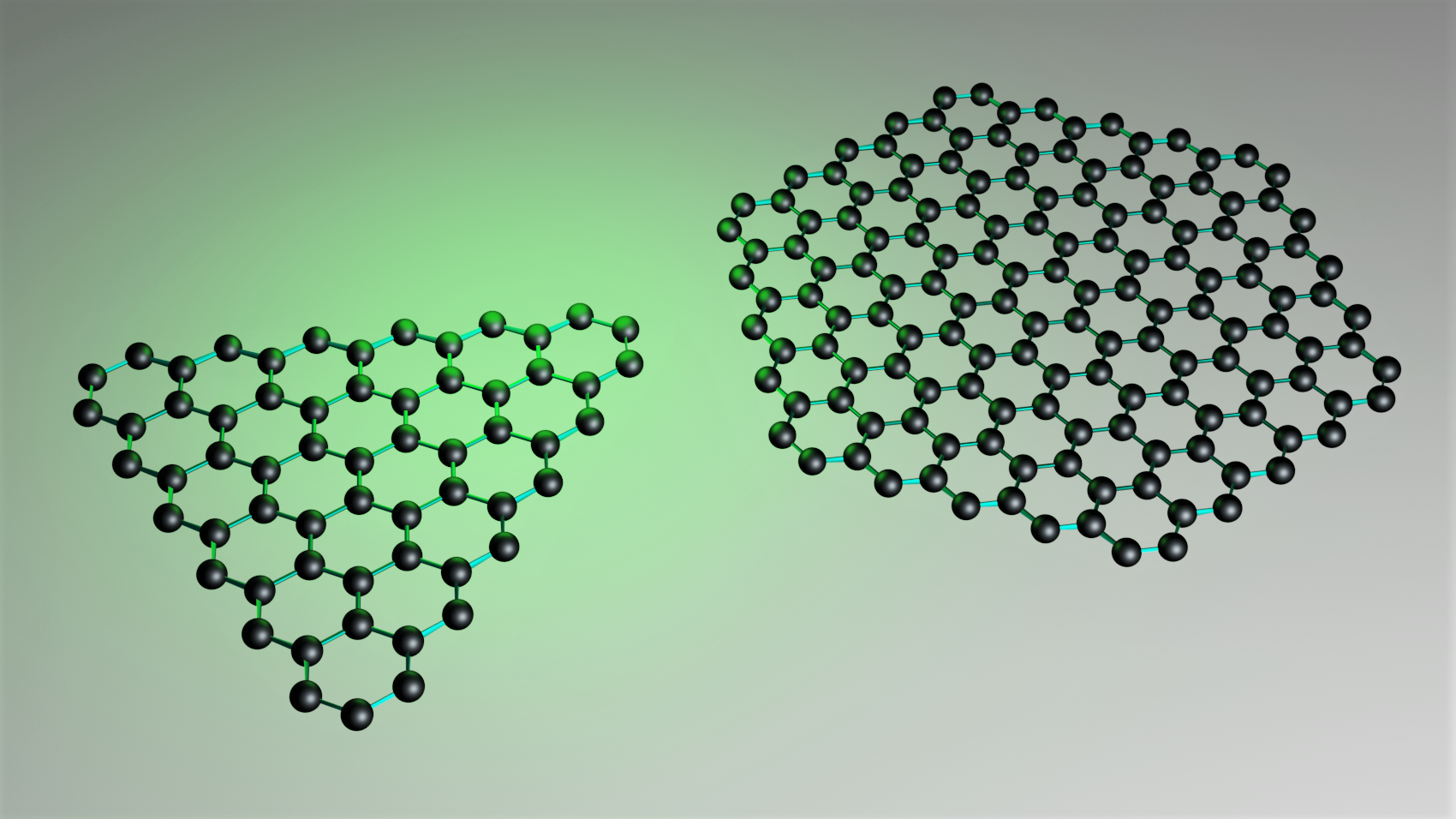
References:
- A. Manjavacas et al., Nanophotonics 2.2, 139-151 (2013)
- J. D. Cox, F Javier García De Abajo, Nat. Comm. 5, 5725 (2014)
- M. M. Müller et al.,Phys. Rev. B 104 (23), 235414 (2021)
- M. Kosik et al., Nanophotonics 11.14, 3281-3298 (2022)
- A. Ghosh et al., in preparation
- M. M. Müller et al., J. Phys. Chem. C 124 (44), 24331-24343 (2020)
- D. Dams et al., resubmitted
- M. Pelc et al., Phys. Rev. A 109 (2), 022237 (2024)
Polaritonic chemistry in Fabric-Perot cavities is a many body phenomena that is driven by collective effects. In the last years, many types of effects have been identified, ranging from collective nuclear motion, to collective effects in the electronic structure. In this contribution, I will summarize our findings from the last few years and discuss our work on cavity Born-Oppenheimer Hartree-Fock and the higher excited states of the Tavis-Cummings model.
We have derived an analytical formulation of static polarizabilities [1] within linear-response theory for molecules under strong coupling using the cavity Born–Oppenheimer Hartree–Fock ansatz. This ab-initio method consistently describes vibrational strong coupling and electron–photon interactions even for ensembles of molecules. For different types of molecular ensembles, we observed local changes in the polarizabilities and dipole moments that are induced by collective strong coupling. Furthermore, we used the polarizabilities to calculate vibro-polaritonic Raman spectra in the harmonic approximation. This allows us to comprehensively compare the effect of vibrational strong coupling on IR and Raman spectra on an equal footing.
Polaritonic chemistry in the electronic strong coupling regime are typically interpreted in terms of the Jaynes-Cummings or Tavis-Cummings models under the assumption that the molecular ensemble is only excited by a single photon. In such a model, two polariton states compete with an overwhelming number of dark states, inhibiting polaritonic reactions entropically. We analyze the higher excitation manifolds of the Tavis-Cummings model along with a three-level system that resembles photochemical reactions [2]. We demonstrate that allowing for more than a single excitation makes the reaction of the involved polaritons entropically more favorable.
References:
- T. Schnappinger, M. Kowalewski, ”Molecular Polarizability under Vibrational Strong Coupling”, J. Chem. Theory Comput. (2025).
- L. Borges, T. Schnappinger, M. Kowalewski, ”The role of dark polariton states for electronic strong coupling in molecules”, arXiv:2504.20798 (2025).
Experiments suggest that molecular photochemistry can change inside optical cavities. These changes are attributed to the collective coupling between molecules and confined light modes, which hybridize into polaritonic states that combine features of light and matter. Yet the microscopic mechanisms underlying these effects remain poorly understood. A key challenge is the delocalized nature of polaritonic states, which are coherent superpositions of molecular and cavity excitations, making it difficult to link polariton formation to local photochemistry. To address this, we combine quantum optics with non-adiabatic molecular dynamics in a multiscale simulation framework for atomistic modeling of molecules in cavities. Contrary to prevailing expectations, our simulations suggest that polariton formation does not significantly alter molecular reactivity, challenging current interpretations of cavity-induced photochemistry.
- Departamento de Física Teórica de la Materia Condensada, Universidad Autónoma de Madrid, Spain
- Condensed Matter Physics Center (IFIMAC), Universidad Autónoma de Madrid, Spain
- Université de Strasbourg, CNRS, Institut de Physique et Chimie des Matériaux de Strasbourg, France
After giving an overview of recent results on polaritonic as well as on topological systems in the context of time-varying media, we discuss in this talk the interplay between topology and the strong coupling regime in a static medium. To this end, we consider a dimerized chain of emitters strongly coupled to a multimode optical cavity, a system that mimics a variation with a photon-mediated long-range coupling of the paradigmatic Su-Schrieffer-Heeger model of one-dimensional topology.
In the strong-coupling regime, cavity photons hybridize the bright dipolar band into a polaritonic one, renormalizing the eigenspectrum and strongly breaking chiral symmetry. This leads to a formal loss of the mid-gap edge states present in the topological phase, with their merging into the polaritonic bulk band. Interestingly, however, bulk polaritons in resonance with the former edge states inherit part of their localization properties, so that multiple polaritonic edge states are observed. Instead of being degenerate, polaritonic edge states occupy a large portion of the spectrum, and due to their polaritonic nature, they exhibit efficient edge-to-edge transport characteristics.
While such hybridized edge states are clearly originating from a polaritonic effect, we unveil that purely mirror-induced, non-polaritonic effects can also play a major role in the interplay between topology and cavity photons. Indeed, we show that the boundary conditions that a cavity imposes on the electromagnetic field, independently of polaritons, may protect edge states against the effects of strong light-matter coupling. Moreover, image charges induced by the cavity’s mirrors may induce additional topological phase transitions even in the case of highly off-resonant photons. This sheds light on the importance of quasistatic and mirror-induced effects in the study of polaritonics.
References:
- T. F. Allard and G. Weick, Phys. Rev. B 108, 245417 (2023).
- T. F. Allard and G. Weick, Phys. Rev. B, 110, 125423 (2024).
Molecular systems in nanophotonic environments exhibit rich optical behaviors, especially when one goes beyond idealized models of dipolar transitions and homogeneous broadening. In this talk I will present two recent studies that explore different frontiers of molecular light-matter coupling. In the first part of the talk I will discuss our recent work extending the Kubo-Anderson stochastic theory of molecular spectral line shapes to the case of polaritons formed in the collective strong coupling regime [1]. I will discuss both the fast and slow limits of the emitter’s frequency modulations, as well as the intermediate regime, and show how the interplay between the characteristic timescales of the cavity and the molecular disorder is expressed in the observed polaritons lineshapes. In the second part of the talk I will turn to plasmonic nanocavities and show how these can activate optically dark transitions in beta-carotene via strong field gradients [2]. I will discuss the interplay between the Franck-Condon quadrupole and the Herzberg-Teller dipole contributions in governing the absorption and photoluminescence characteristics of this dark transition. Together, these studies illustrate how both disorder and multipolar light-matter interactions can be leveraged to reveal and control spectral complexity in molecular systems.
References:
- C. Climent, J.E. Subotnik, A. Nitzan, Physical Review A 109, 052809 (2024).
- J. Huang, O.S. Ojambati, C. Climent, A. Cuartero-Gonzalez, E. Elliott, J. Feist, A.I. Fernández-Domínguez, J.J. Baumberg, ACS nano 18 , 14487 (2024)
Strong light-matter interactions are at the heart of many electromagnetic phenomena and play a key role in the rapidly evolving field of nanophotonics. In this talk, I will present several systems that support polaritons—hybrid quasiparticles arising from the strong coupling between photons and excitations in matter—and discuss their promise for future applications. I will begin by highlighting recent advances in transition metal dichalcogenides (TMDs), focusing on their one-dimensional edges and the rich physics they host [1–2]. A central theme of the talk will be the concept of self-hybridization, wherein both the photonic and material components of a polaritonic system originate from the same nanostructured material [1–4]. We have recently realized such systems in TMD nanostructures and levitated water droplets, demonstrating both electronic and vibrational strong coupling [1–5]. Water droplets are particularly intriguing due to their abundance in natural environments such as mists, fog and clouds. I will also present our findings on the spontaneous formation of Fabry-Pérot resonators in aqueous solutions of gold nanoflakes [6–8]. This phenomenon arises from a delicate interplay between attractive Casimir-Lifshitz and repulsive electrostatic forces, leading to a self-assembled optical cavity. These results not only point to novel pathways in self-assembled polaritonic systems but also offer a new perspective on the unification of Casimir and strong-coupling physics.
References:
- B. Munkhbat, A. B. Yankovich, D. G. Baranov, R. Verre, E. Olsson, T. O. Shegai, Nat. Commun. 11, 4604 (2020)
- B. Munkhbat, B.Kücüköz, D. G. Baranov, T. J. Antosiowicz, T. O. Shegai, Laser Photonics Rev. 17, 2200057 (2022)
- G. Zograf, A.Y.Polyakov, M. Bancerek, T.J. Antosiowicz, T. O. Shegai, Nat. Photon. 18, 751–757 (2024)
- A. Canales, D. G. Baranov, T.J. Antosiowicz, T. O. Shegai J. Chem. Phys. 154, 024701 (2021)
- A. Canales, O. V. Kotov, B. Kücüköz, T. O. Shegai, Phys. Rev. Lett., 132, 193804 (2024)
- B. Munkhbat, A. Canales, B. Kücüköz, D. G. baranov, T. O. Shegai, Nature, 597, 214-219 (2021)
- F. Schmidt, A. Callegari, A. Daddi-Moussa-Ider, B. Munkhbat, R. Verre, T. O. Shegai, M. Käll, H. Löwen, A. Gambassi, G. Volpe Nat. Phys., 19, 271-278 (2023)
- B. Kücüköz, O. V. Kotov, A. Canales, A.Y. Polyakov, A.V. Agrawal, T. J. Antosiowicz, T. O. Shegai Sci. Adv., 10, eadn1825 (2024)
Molecular polaritonics faces well-recognized challenges from disorder and absorption-the “dark state problem’ where molecular inhomogeneity creates loss mechanisms from polaritonic states into dark reservoirs, and unavoidable cavity losses that limit coherent dynamics. Here, I present a system in which these same drawbacks become computational assets. By engineering nanoscale hypersonic phonon transport in two-dimensional platforms [1], we create optomechanical systems where Anderson-localized optical modes [2] arise from fabrication disorder prediction (Figure 1a). The combination of spatial optomechanical coupling [3] and optical absorption [4] leads to nonlinear dynamics and memory essential for reservoir computing. These generate rich temporal dynamics with the high-dimensional phase spaces necessary for machine learning tasks like pattern recognition and time-series prediction (Figure 1b).
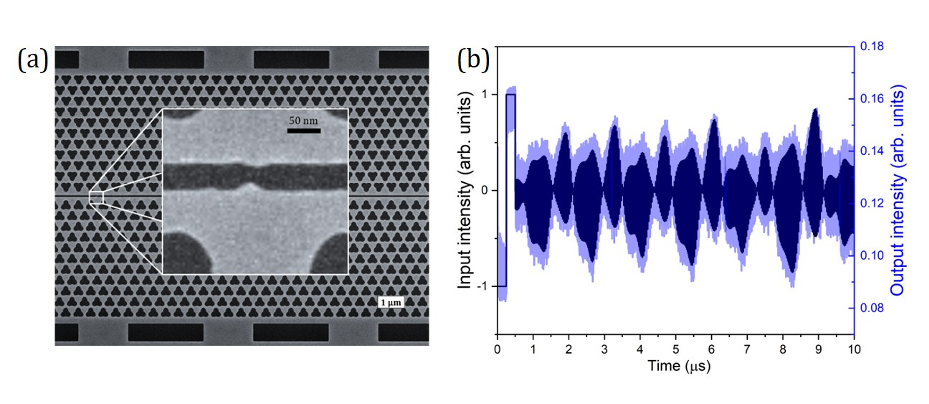
References:
- O. Florez, G. Arregui, M. Albrechtsen, R. C. Ng, J. Gomis-Bresco, S. Stobbe, C. M. Sotomayor-Torres, P. David García. Engineering nanoscale hypersonic phonon transport. Nature Nanotechnology 17, 947 (2022).
- G. Arregui, R. Cecil Ng, M. Albrechtsen, S. Stobbe, C. M. Sotomayor Torres, P. David García. Cavity optomechanics with Anderson-localized optical modes. Phys. Rev. Lett. 130, 043802 (2023).
- G. Madiot, R. C Ng, G. Arregui, O. Florez, M. Albrechtsen, S. Stobbe, P. D Garcia, C. M Sotomayor-Torres. Optomechanical generation of coherent GHz vibrations in a phononic waveguide. Phys. Rev. Lett. 130, 106903 (2023).
- G. Arregui, D. Navarro-Urrios, N. Kehagias, C.M.S. Torres, P.D. Garcia. All-optical radio-frequency modulation of Anderson-localized modes. Physical Review B 98 (18), 180202 (2018).
Placing a molecule in a cavity modifies its local photonic environment. It boosts light-matter interaction, which can be used to improve the performance of single-photon sources [1] or to perform nonlinear spectroscopy on individual molecules [2,3]. I will show that self-assembled plasmonic nanocavities allow ultra-broadband photonic engineering and illustrate this opportunity with two experiments. First, a single commercial fluorophore is precisely positioned inside a plasmonic dimer with the help of DNA origami and experiences a giant Purcell factor (~10^5) and Lamb shift (>10 meV). Together with the presence of a near-infrared plasmonic mode, this extreme photonic environment completely reshapes the emission spectrum into the near-infrared, where molecules are poor emitters. [4] Second, a nanocavity supporting colocalized mid-infrared and visible resonances is realized using the “nanoparticle-on-slit” concept [5,6] and is used for vibrational sum- and difference frequency spectroscopy on a small ensemble of molecules. Compared to previous results [5], I will show data covering an extended spectral range from 900 to 1650 cm-1, giving access to the full IR vibrational fingerprint of the molecules. I will conclude with some prospects of using this system in the single-molecule regime for physical chemistry and quantum optics. [7]
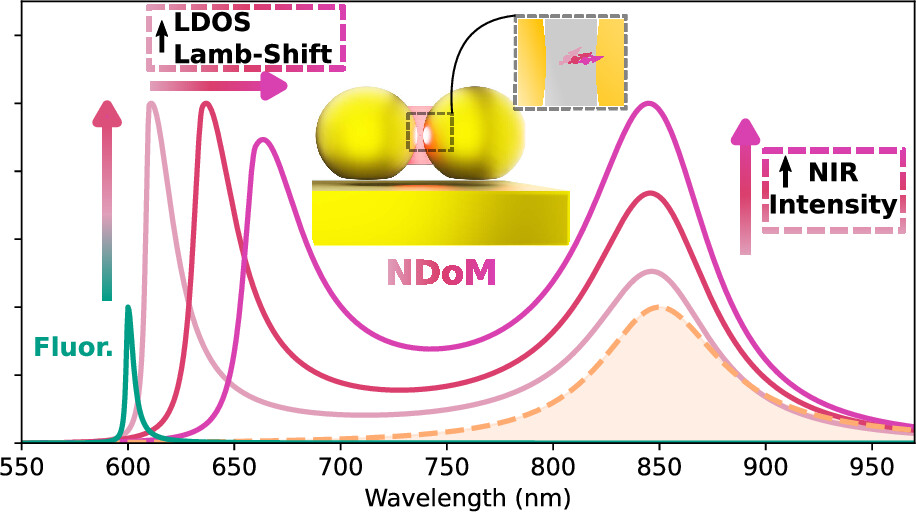
References:
- L. Husel, A., et al. “Cavity-enhanced photon indistinguishability at room temperature and telecom wavelengths.” Nature Communications 15, 3989 (2024)
- Schörner, Christian, and Markus Lippitz. “Single molecule nonlinearity in a plasmonic waveguide.” Nano Letters 20, 2152-2156 (2020)
- Maser, A., Gmeiner, B., Utikal, T., Götzinger, S., & Sandoghdar, V. “Few-photon coherent nonlinear optics with a single molecule.” Nature Photonics, 10, 450-453 (2016)
- Verlekar, Sachin, et al. “Giant Purcell broadening and Lamb shift for DNA-assembled near-infraredquantum emitters”, ACS Nano 19, 3172–3184 (2025)
- Chen, Wen, et al. “Continuous-wave frequency upconversion with a molecular optomechanical nanocavity.” Science 374, 1264-1267 (2021)
- Hu, Huatian, et al. “Plasmonic Nanoparticle-in-nanoslit Antenna as Independently Tunable Dual-Resonant Systems for Efficient Frequency Upconversion” (2025) preprint: arXiv:2505.10668
- Moradi Kalarde, Fatemeh, et al, “Photon antibunching in single-molecule vibrational sum-frequency generation” Nanophotonics 14, 59-73 (2025)
The coupling of molecular transitions to plasmonic resonances is of broad interest as it can strongly affect the molecular electronic structure, thus resulting in modified energy landscape and electron-transfer pathways [1]. Here, we study the interaction of molecular photoswitches with plasmonic nanoantennas, which display two spectrally separated orthogonal localized surface plasmon resonances (LSPRs). The nanoantenna dimensions are designed such that the molecular transition is resonant with the long axis LSPR, whereas it is detuned from the short axis LSPR, resulting in either strong or weak coupling interactions, respectively. Ultrafast pump-probe spectroscopy measurements reveal a sub-ps collapse of polaritons to pure molecular transition triggered by femtosecond-pulse excitation. To interpret the results, we rely on a full quantum description based on the extension of the Tavis-Cummings Hamiltonian [2] and we show that the response of the system is governed by intramolecular dynamics, occurring one order of magnitude faster with respect to the uncoupled excited molecule relaxation to the ground state [3].
References:
- P. Vasa, W. Wang, R. Pomraenke, M. Lammers, M. Maiuri, C. Manzoni, G. Cerullo, and C. Lienau, Nat. Photonics 7, 128, (2013).
- M. Tavis and F. W. Cummings, Phys. Rev. 170, 379 (1968).
- J. Kuttruff, M. Romanelli, E. Pedrueza-Villalmanzo, J. Allerbeck, J. Fregoni, V. Saavedra-Becerril, J. Andréasson, D. Brida, A. Dmitriev, S. Corni, and N Maccaferri, Nat. Commun. 14, 3875 (2023).
- Department of Chemistry and Applied Biosciences, ETH Zürich, Zürich, Switzerland
- NNF Quantum Computing Programme, Niels Bohr Institute, University of Copenhagen, Copenhagen, Denmark
Experiments have demonstrated that collective strong coupling between molecular vibrations and a Fabry-Pérot cavity mode can significantly change molecular properties, such as thermal reaction rates and equilibrium constants. However, despite the plethora of theoretical studies, the mechanism behind this change is still not well-understood. In order to make progress, we take a step back and lift some of the approximations that nearly all reactivity studies are based on, namely the single mode approximation and the neglect of Coulombic intermolecular interactions. By restraining ourselves to statistical properties, such as the equilibrium constant, we can cast the problem into the framework of discretised path integrals. This allows us to circumvent the explicit simulation of the continuum of electromagnetic modes; instead, we capture their effect in an influence functional. With this method we can calculate how adding a pair of mirrors changes the equilibrium constant of a small ensemble of molecules represented by double-well potentials. Based on what experimental features this approach can and cannot capture, we hope to shed light on which approximations are valid, and spur a systematic analysis of which thus-far neglected effects could play an important role in changing chemical reactivity.
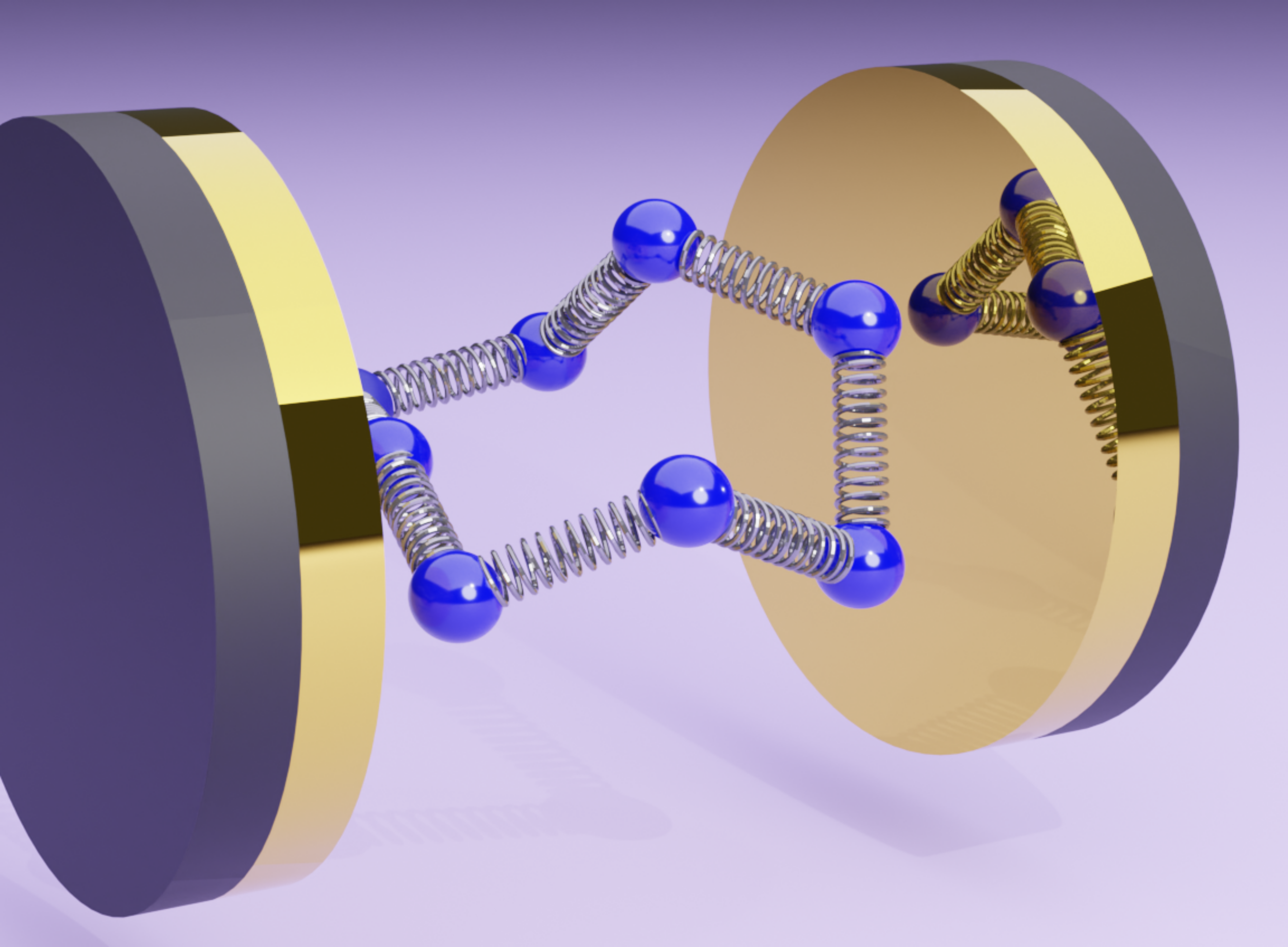
- Max Planck Institute for the Science of Light, Erlangen, Germany
- University of Erlangen–Nuremberg, Erlangen, Germany
In this talk, I will present our recent advancements in the controlled coupling of single molecules to optical microcavities. First, I will discuss a tunable Fabry-Perot microcavity operating in the strong coupling regime of cavity quantum electrodynamics (CQED), where the Purcell factor is significantly enhanced, effectively transforming the molecule into a two-level quantum system. Our experiments show a remarkable 99% extinction of a laser beam, indicating that the molecule-cavity system behaves as an almost perfect photon scatterer. In the second part, I will present our work on integrated microcavities, where two molecules are coupled via the modes of a microdisk.
Weak light-matter coupling conditions allow to generate bright single photon emission from solid-state sources. In this talk we will present results on quantum dots in monolayers of WSe2, and defects in hexagonal Boron Nitride, that are coupled to a tunable Fabry-Pérot microcavity, rendering a bright single photon emission. The nanoscale control of light-matter interactions allows to create new optoelectronic devices for a wide span of nonlinear and quantum photonic applications. A key part of this endeavour is the exploration of novel materials, which reveal unique properties that can be tailored to specific applications. Regarding the implementation of solid-state single photon sources, relevant emergent materials for quantum light emission are quantum dots in transition metal dichalcogenides monolayers, perovskite quantum dots, or also defects in hexagonal boron nitride nanocrystals. [1] An optimal single-photon source should satisfy three essential criteria: (1) the emission of photons “on demand”, (2) emit one photon at a time, and (3) high degree of temporal coherence and uniformity in the properties of emitted photons (spectrum, polarization, spatial mode). Achieving this ideal quantum performance relies on using a resonant cavity to enhance the emitter’s spontaneous decay rate via the Purcell effect. In the first part of this talk, we will present recent advancements in generating single photons from atomically thin WSe2 monolayers. Local stress within these monolayers creates a confining potential that traps single excitons, resulting in single-photon emission. By embedding these quantum dots in a cryogenic Fabry-Pérot optical cavity, we achieve record emission-efficiency levels. [2] We also study the filtering cavity effects on the temporal coherence of the emitted single photons via Michelson interferometry. [3] Initial quantum communication tests with these sources further demonstrate their viability for single-photon applications. [4] In the latter part of the talk, I will discuss our experimental progress with an alternative material platform: single defects in hexagonal boron nitride. This emitter, operable at ambient conditions and integrated with a Fabry-Pérot cavity, offers a promising option for cryogenic-free quantum optical applications, including free-space quantum key distribution.
References:
- M. Esmann, S. C. Wein, and C. Antón-Solanas, Solid-State Single-Photon Sources: Recent Advances for Novel Quantum Materials, Advanced Functional Materials 34, 2315936 (2024).
- J.-C. Drawer et al., Monolayer-Based Single-Photon Source in a Liquid-Helium-Free Open Cavity Featuring 65% Brightness and Quantum Coherence, Nano Lett. 23, 8683 (2023).
- V. N. Mitryakhin et al., Engineering the Impact of Phonon Dephasing on the Coherence of a ${\mathrm{WSe}}_{2}$ Single-Photon Source via Cavity Quantum Electrodynamics, Phys. Rev. Lett. 132, 206903 (2024).
- T. Gao, M. von Helversen, C. Antón-Solanas, C. Schneider, and T. Heindel, Atomically-thin single-photon sources for quantum communication, npj 2D Mater. Appl. 7, 4 (2023).
- POLIMA—Center for Polariton-driven Light–Matter Interactions, University of Southern Denmark, Odense M, Denmark
- SUPA, School of Physics and Astronomy, University of St Andrews, UK
- Molecular Quantum Solutions, Søborg, Denmark
- Department of Chemistry and Biochemistry, University of California San Diego, La Jolla, CA, USA
Intramolecular energy transfer driven by near-field effects plays an important role in applications ranging from biophysics and chemistry to nano-optics and quantum communications. Advances in strong light–matter coupling in molecular systems have opened new possibilities to control energy transfer. In particular, long-distance energy transfer between molecules has been reported as the result of their mutual coupling to cavity photon modes, and the formation of hybrid polariton states. In addition to strong coupling to light, molecular systems also show strong interactions between electronic and vibrational modes. The latter can act as a reservoir for energy to facilitate off-resonant transitions, and thus energy relaxation between polaritonic states at different energies. However, the non-Markovian nature of those modes makes it challenging to accurately simulate these effects. Here we capture them via process tensor matrix product operator (PT-MPO) methods, to describe exactly the vibrational environment of the molecules combined with a mean-field treatment of the light–matter interaction. In particular, we study the emission dynamics of a system consisting of two spatially separated layers of different species of molecules coupled to a common photon mode, and show that the strength of coupling to the vibrational bath plays a crucial role in governing the dynamics of the energy of the emitted light; at strong vibrational coupling this dynamics shows strongly non-Markovian effects, eventually leading to polaron formation. Our results shed light on polaritonic long-range energy transfer, and provide further understanding of the role of vibrational modes of relevance to the growing field of molecular polaritonics.
Single organic molecules embedded in the solid state have emerged as powerful platforms for quantum optics, thanks to their coherent optical transitions mediated by isolated electronic levels [1]. However, these systems are not limited to electronic degrees of freedom but also include nuclear and spin levels, making them inherently hybrid quantum systems. This could open new possibilities for applications in molecular quantum technologies, including quantum memories, spin-photon interfaces, and optomechanics [2]. Additionally, leveraging the vast chemical space of molecules offers significant opportunities to tailor and optimize these systems.
In this talk, I present single organic molecules as hybrid quantum systems, with a particular focus on their vibrational dynamics and potential implications for quantum technologies. I discuss the challenges associated with modeling vibrational interactions arising from long-range molecular forces. To address the computational bottlenecks, I demonstrate how Machine Learning Interatomic Potentials (MLIPs) can be used to model these dynamics [3]. By evaluating the accuracy, reliability, and extrapolation capability of MLIPs for vibrational modeling, I show their potential to enable scalable simulations of host-guest systems.
References:
- C. Toninelli, I. Gerhardt, A. S. Clark, A. Reserbat-Plantey, S. Götzinger, Z. Ristanović, M. Colautti, P. Lombardi, K. D. Major, I. Deperasińska, W. H. Pernice, F. H. L. Koppens, B. Kozankiewicz, A. Gourdon, V. Sandoghdar, and M. Orrit, Nat. Mater. 20, 1615 (2021).
- B. Gurlek, D. Wang, Phys. Rev. Res. 7(2), 021001 (2025).
- B. Gurlek, S. Sharma, P. Lazzaroni, A. Rubio, and M. Rossi,arXiv preprint arXiv:2504.11224 (2025).
A promising route toward building quantum light–matter interfaces with rare-earth ions (REIs) lies in the nano-fabrication of crystalline host materials that preserve the quantum properties of REIs while allowing integration into nanophotonic devices. In this context, molecular chemistry offers a highly attractive approach, providing unparalleled flexibility in material composition, precise structural control, and excellent integration potential. In this presentation, we review a series of europium-based molecular crystals that exhibit record-narrow optical linewidths and long spin coherence times [1]. We discuss their prospects as a novel material platform for photonic quantum technologies.
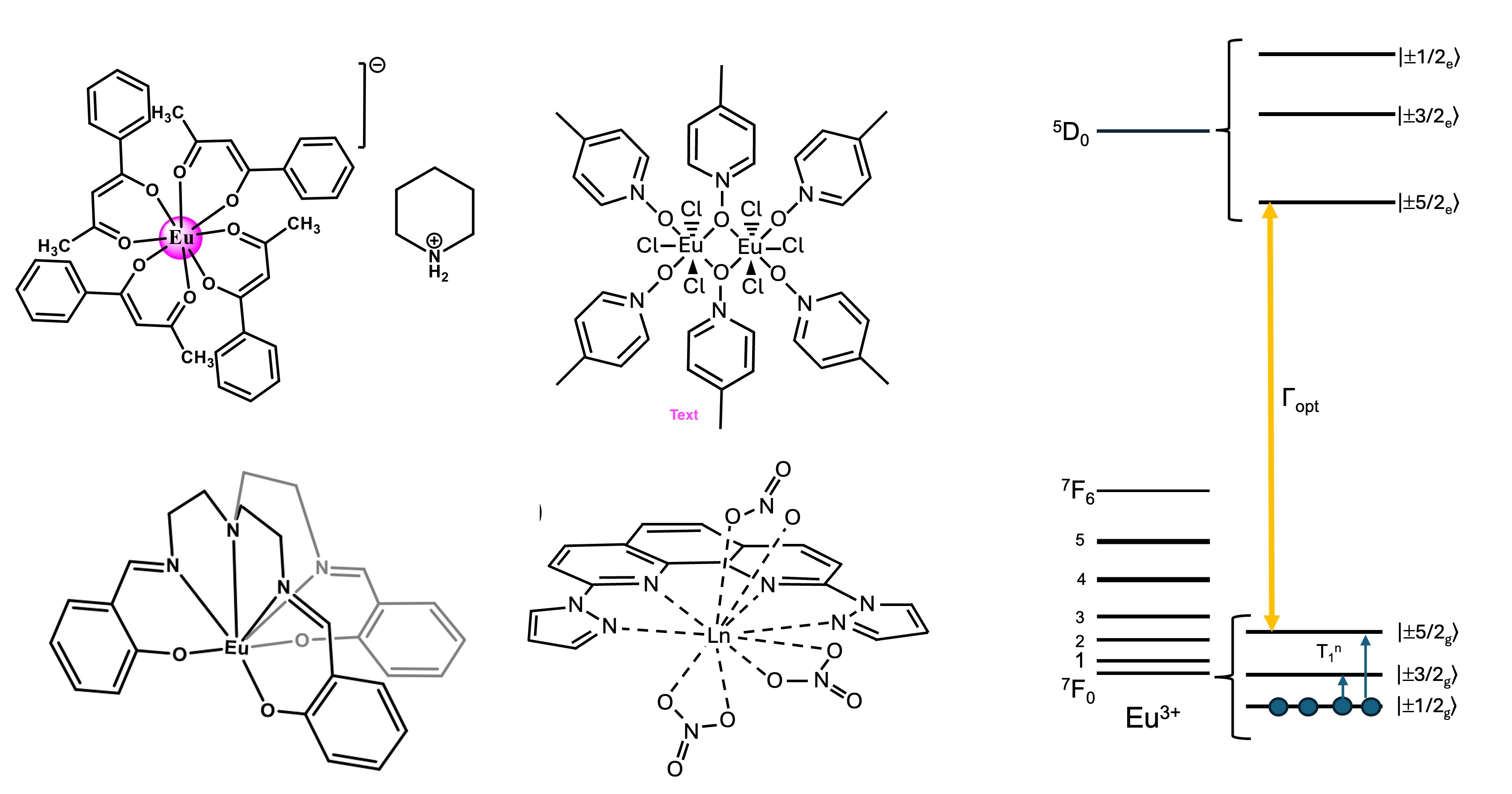
References:
- S.K. Kuppusamy, D, Hunger, M. Ruben, P. Goldner and D. Serrano, Nanophotonics 13(24): 4357–4379 (2024)
- Université Paris-Saclay, ENS Paris-Saclay, CentraleSupélec, CNRS, LuMIn, Orsay, FR
- LICSEN, NIMBE, CEA, Paris-Saclay University, Gif-sur-Yvette, FR
In the context of the development of new molecular quantum emitters, nanographenes have great assets. Indeed, their synthesis by bottom-up chemistry allows a total control on their structure, which opens the way to wide customization of their optical properties [1–3]. In particular, we have shown that nanographenes are efficient single photon emitters at room temperature with tunable energy and transition dipole amplitude [4-7]. The next step would be to reach the emission of indistiguishable photons at low temperature. In this talk, I will in particular report on a study of the photophysics of nanographenes embedded in original molecular crystals. I will describe the synthesis and characterization of these original molecular crystals and the protocol to embed the GQDs. Finally, I will show photoluminescence studies of GQDs down to the single nanographene both at room and low temperature [8].
References:
- M. G. Debije, J. Am. Chem. Soc. 126, 4641 (2004)
- X. Yan, X. Cui, and L.-S. Li, J. Am. Chem. Soc. 132, 5944 (2010)
- A. Konishi et al, J. Am. Chem. Soc. 132, 11021 (2010)
- S. Zhao et al, Nature Communications, 9, 3470 (2018)
- T. Liu et al, Nanoscale, 14, 3826 – 3833 (2022)
- T. Liu et al, Journal of Chemical Physics 156, 104302 (2022)
- D. Medina-Lopez et al, Nature Communications 14, 4728 (2023)
- Thanh Trung Huynh, in preparation
- CNR Nanotec, Institute of Nanotechnology, via Monteroni, 73100 Lecce, Italy
- Institute of Semiconductor and Solid State Physics, Johannes Kepler University, 4040 Linz, Austria
Exciton polaritons are hybrid quasi-particles resulting from the strong coupling between photons and excitons in semiconductors, offering exciting possibilities for advanced optoelectronic and quantum technologies that operate at room temperature. Recently, two-dimensional (2D) semiconductors, such as transition metal dichalcogenides (TMDs) and hybrid organic-inorganic perovskites, have attracted significant attention due to their unique optical and electronic properties, including high excitonic binding energies [1] and strong quantum confinement. These features make them ideal platforms for exploring strong light-matter interactions and exciton-polariton phenomena up to ambient conditions. In this work, we investigate methods to maximize the cooperativity and nonlinearities of exciton-polaritons in 2D materials at room temperature [2]. We present two innovative approaches using TMDs: first, coupling excitons to a topologically protected bound state in the continuum (BIC) within a Bloch surface wave structure to enhance light-matter interaction while minimizing photonic losses; second, integrating suspended TMD monolayers within resonant microcavities to further reduce losses and amplify nonlinear polaritonic effects, achieving record interaction constants. Additionally, we explore the potential of other 2D materials, including perovskite microwires, to facilitate long-range polariton propagation and develop proof-of-concept devices like polaritonic switches operating efficiently at room temperature. Our findings demonstrate significant progress in controlling and enhancing exciton-polariton interactions in 2D semiconductors, paving the way for cost-effective, high-performance polaritonic devices that leverage strong coupling and nonlinear phenomena at ambient conditions.
References:
- Zhu, B.; Chen, X.; Cui, X. Exciton binding energy of monolayer WS2. Sci. Rep. 2015, 5, 9218
- Polimeno L., et al. “Strongly enhanced light–matter coupling of monolayer WS2 from a bound state in the continuum.” Nature Materials, 964-969, (2023).
Poster abstracts
- Max Planck Institute for the Science of Light, D-91058 Erlangen, Germany
- Department of Physics, Friedrich-Alexander-Universität Erlangen-Nürnberg (FAU), D-91058 Erlangen, Germany
- TU Darmstadt, Institute for Applied Physics, Hochschulstraße 4A, D-64289 Darmstadt, Germany
- Department of Chemistry and Biochemistry, University of California San Diego, La Jolla, California 92093, USA
- Institut für Theoretische Physik, Universität Innsbruck, A-6020 Innsbruck, Austria
- Department of Theoretical Physics, University of Debrecen, H-4002 Debrecen, Hungary
- ELI-ALPS, ELI-HU Non-Profit Ltd, H-6720 Szeged, Hungary
- Department of Information Technology, University of Debrecen, H-4002 Debrecen, Hungary
- Max Planck Institute for the Structure and Dynamics of Matter and Center for Free-Electron Laser Science, Luruper Chaussee 149, 22761 Hamburg, Germany
- Department of Physics, Harvard University, Cambridge, Massachusetts 02138, USA
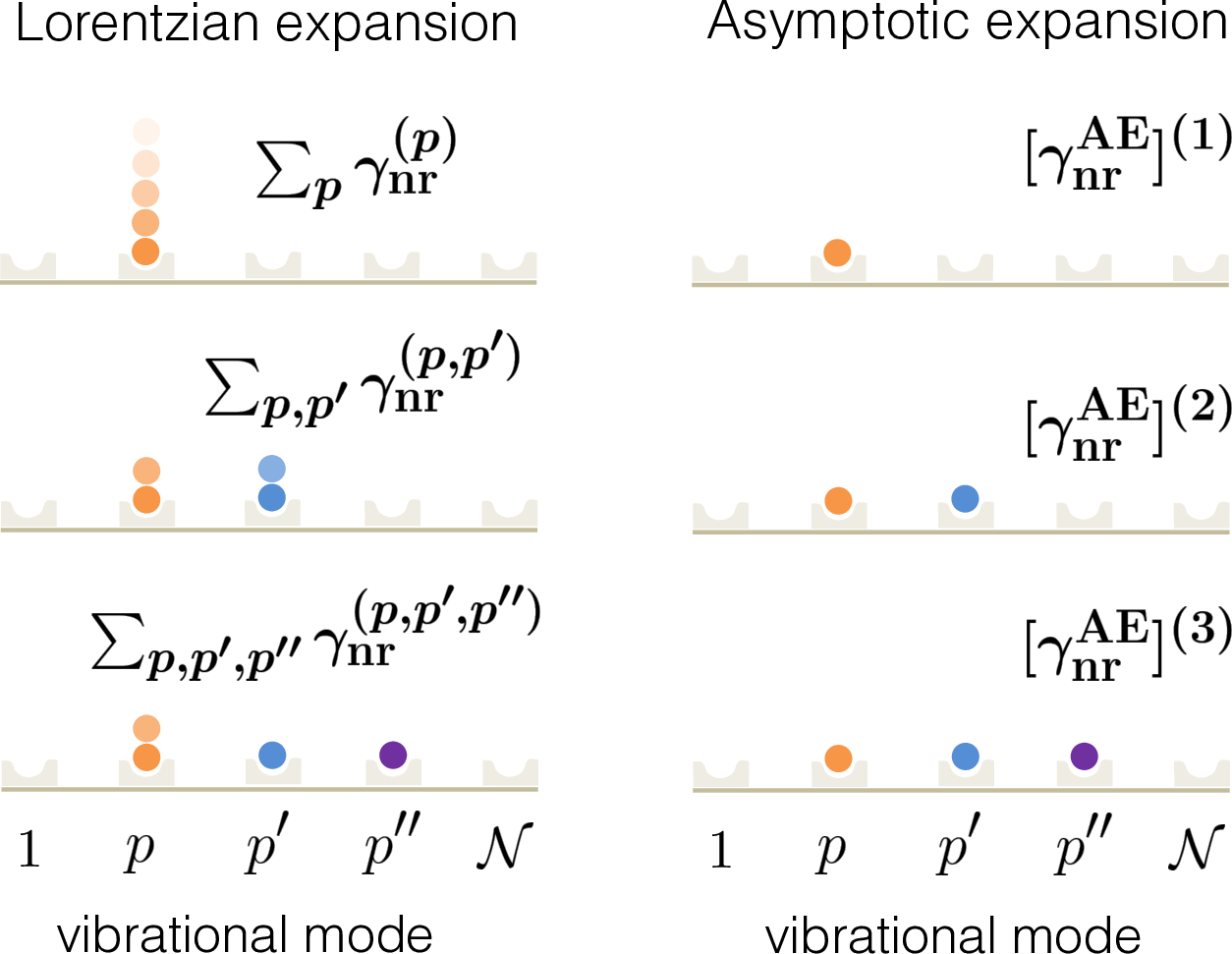
References:
- N. S. Baßler, M. Reitz, R. Holzinger, A. Vibók, G. J. Halász, B. Gurlek, and C. Genes, arXiv:2405.08718 (2024).
- R. Englman and J. Jortner, Mol. Phys. 18, 145 (1970)
- Max Planck Institute of Quantum Optics & Munich Center for Quantum Science and Technology
- Department of Theoretical Condensed Matter Physics & Condensed Matter Physics Center (IFIMAC), Universidad Autónoma de Madrid
- Department of Mathematical Sciences, University of Copenhagen
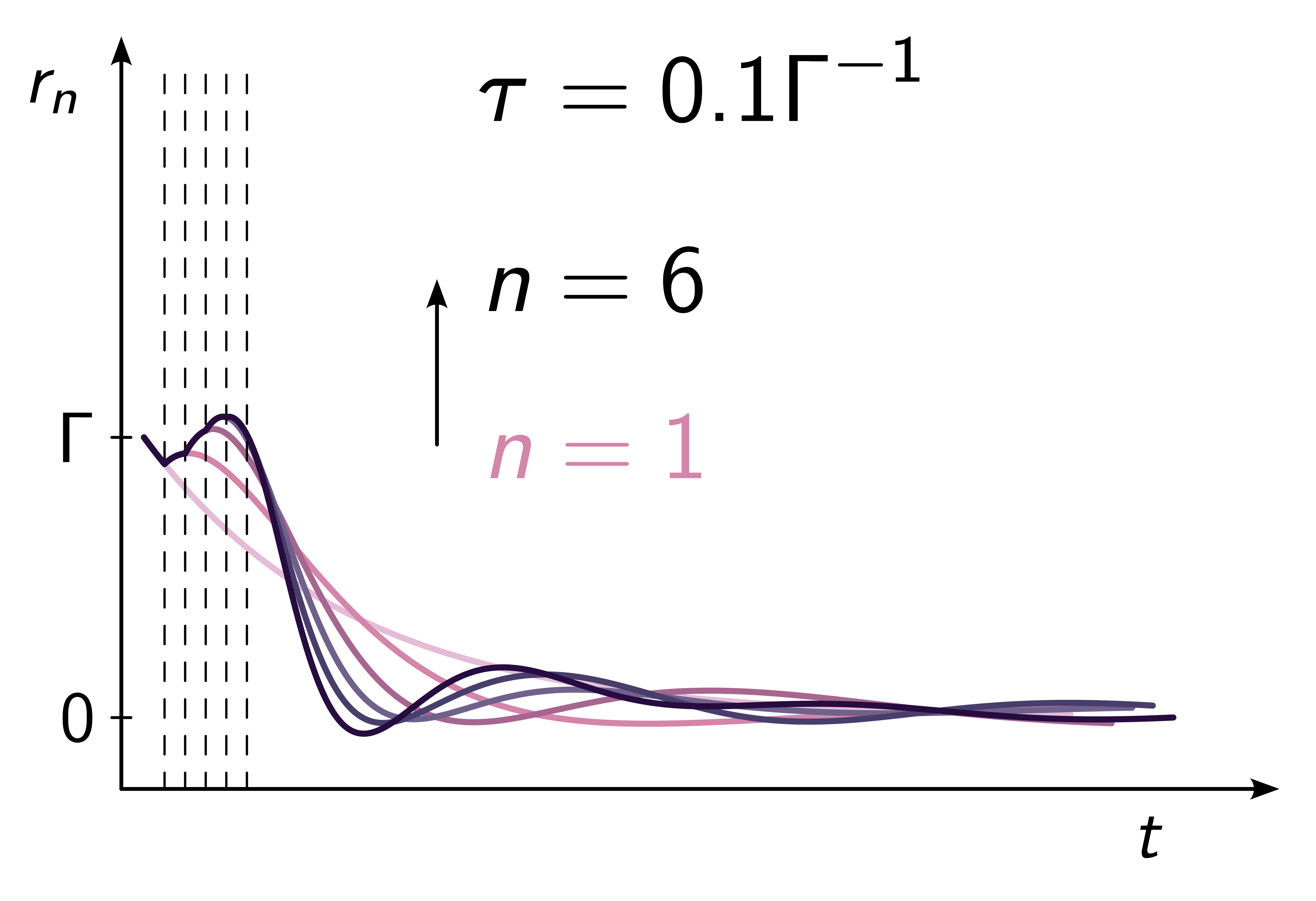
References:
- B. Windt, M. Bello, D. Malz, and J. I. Cirac, Phys. Rev. Lett. 134, 173601 (2025)
- University of Southampton, Southampton, UK
- University of Iceland, Reykjavik, Iceland
- University of Warsaw, Warsaw, Poland
- Université Clermont Auvergne, Clermont–Ferrand, France
- Military University of Technology, Warsaw, Poland
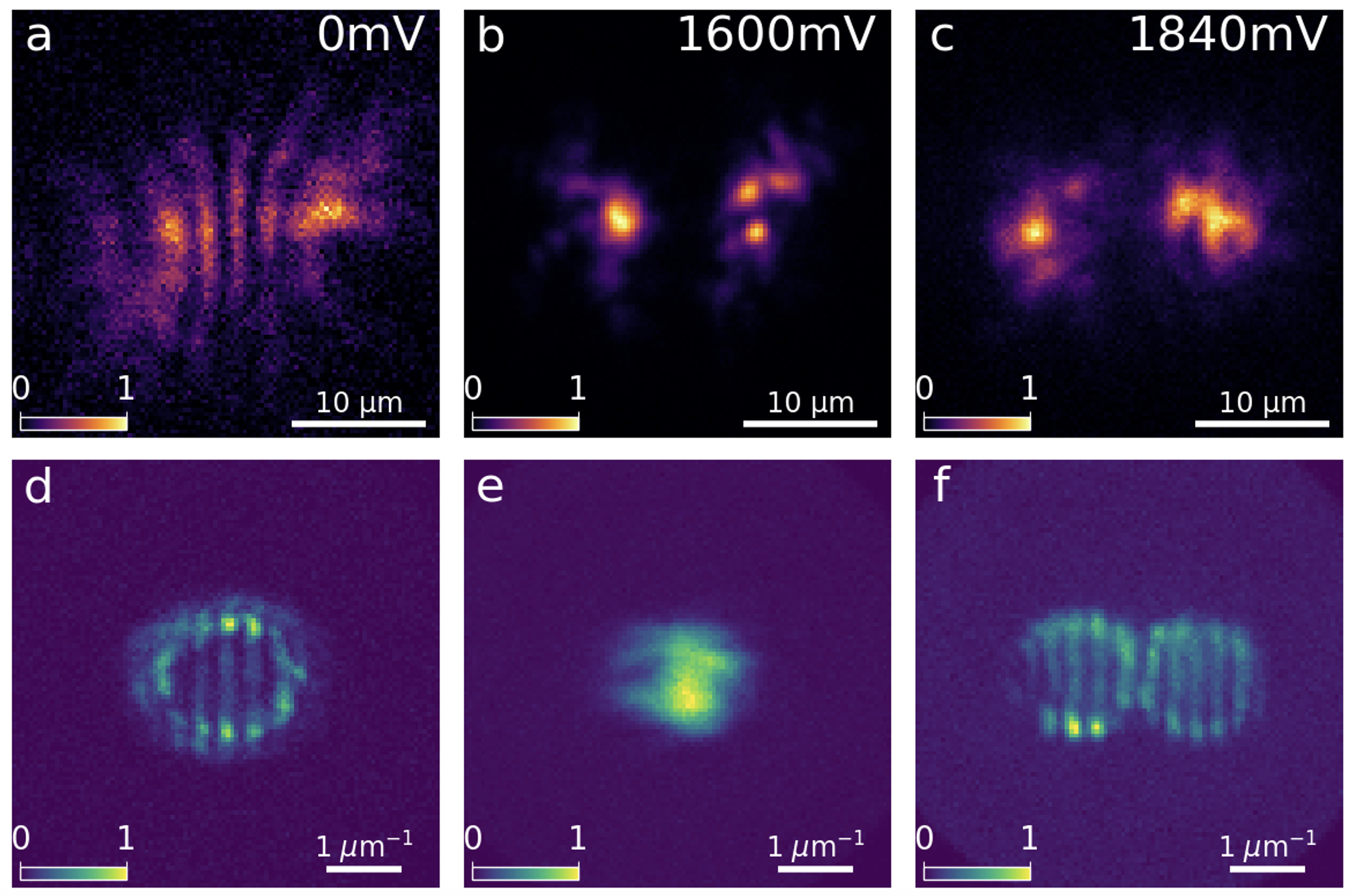
References:
- T. Yagafarov et al., Comm Phys. 3(1), 18 (2020).
- J. D. Töpfer et al., Comm Phys 3(1), 2 (2020).
- Institute of Physics, Faculty of Physics, Astronomy and Informatics, Nicolaus Copernicus University in Toruń, Grudziądzka 5, 87-100 Toruń, Poland
- Dipartimento Interateneo di Fisica, Università degli Studi di Bari, I-70126 Bari, Italy
- International Center of Physics, Institute of Physics, University of Brasilia, 70910-900, Brasilia, DF, Brazil
- Instituto de Física, Universidade de Brasília, Caixa Postal 04455, CEP 70910-900, Brasília, DF, Brazil
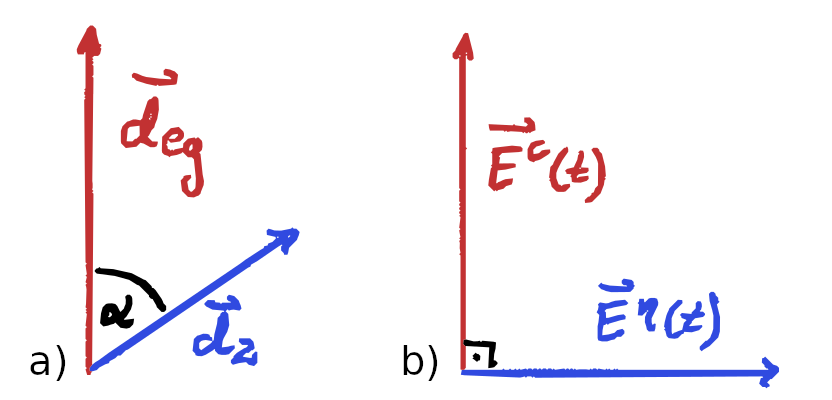
References:
- P. Gładysz, P. Wcisło, and K. Słowik, Sci. Rep. 10(1), 17615 (2020).
- S. Izadshenas, P. Gładysz, and K. Słowik, Opt. Exp. 31(18), 29037-29050 (2023).
- P. Gładysz and K. Słowik, arXiv:2408.13011 (2024).
- Dept. Física de Materiales, Universidad Autónoma de Madrid, 28049, Madrid, Spain.
- Technische Physik, University of Würzburg, 97074 Würzburg,Germany
- Instituto Nicolás Cabrera, Universidad Autónoma de Madrid, 28049, Madrid, Spain
- Instituto de Física de la Materia Condensada, Universidad Autónoma de Madrid, 28049, Madrid, Spain
References:
- T. Jacqmin, I. Carusotto, I. Sagnes, M. Abbarchi, D. D. Solnyshkov, G. Malpuech, E. Galopin, A. Lemaître, J. Bloch, and A. Amo, Phys. Rev. Lett. 112, 116402 (2014)
- S. Klembt et al. Nature 562, 552–556 (2018)
- L.-H. Wu and X. Hu Phys. Rev. Lett. 114, 223901 (2015)
- M. D. Martín, G. Aichmayr, L. Viña, and R. André, Phys. Rev. Lett. 89, 077402 (2002)
- M. Klaas et al. Phys. Rev. B 99, 115303 (2019)
- Department of Physics, Harvard University, Cambridge, Massachusetts 02138, USA
- TU Darmstadt, Institute for Applied Physics, Hochschulstra\ss e 4A, D-64289 Darmstadt, Germany
- Max Planck Institute for the Science of Light, Staudtstra\ss e 2, D-91058 Erlangen, Germany
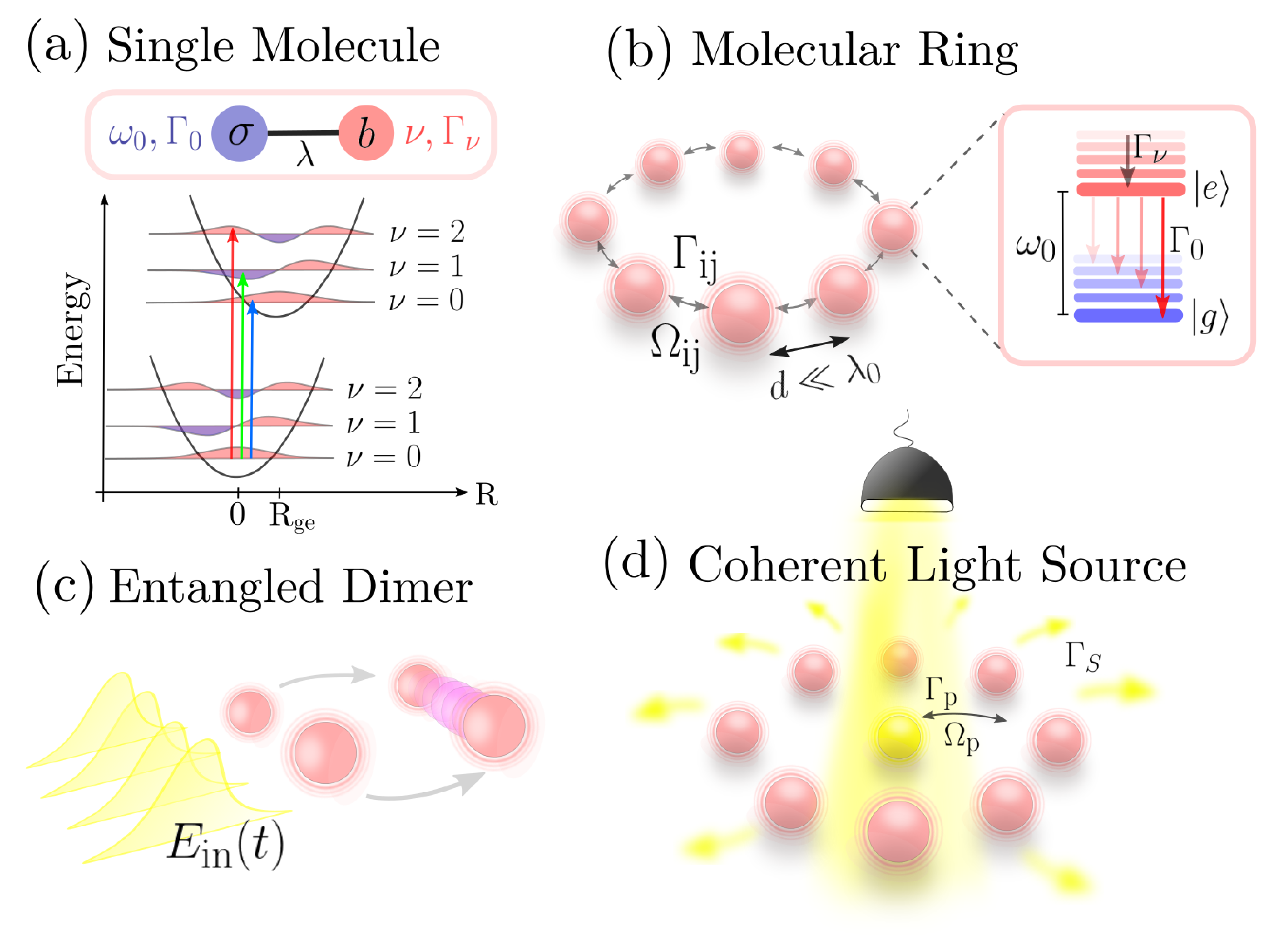
References:
- R. Holzinger, N. S. Bassler, J. Lyne, F. G. Jimenez, J. T. Gohsrich, and C. Genes. Solving dicke superradiance analytically: A compendium of methods, 2025
- R. Holzinger and Claudiu Genes. A compact analytical solution of the dicke superradiance master equation via residue calculus. Zeitschrift für Naturforschung A, June 2025
- R. Holzinger, Susanne F. Yelin, and Claudiu Genes. Dicke superradiance of multilevel atoms: analytical solution. Manuscript in preparation, 2025
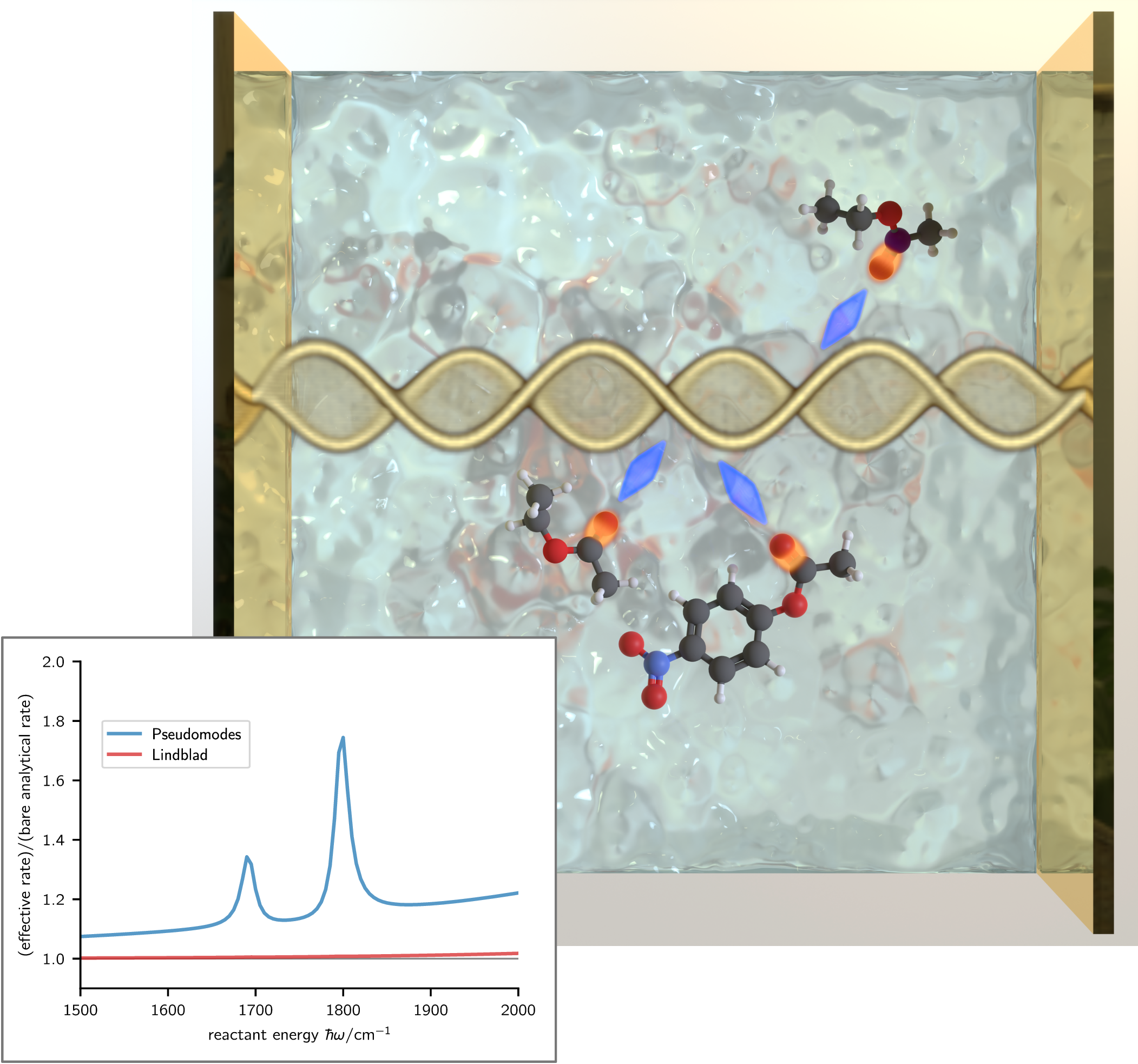
References:
- R.M.A. Vergauwe, A. Thomas, K. Nagarajan et al., Angew. Chem. Int. Ed. 58, 15324 (2019).
- A. Thomas, J. George, A. Shalabney et al., Angew. Chem. Int. Ed. 55, 11462 (2016).
- J. Lather, P. Bhatt, A. Thomas et al., Angew. Chem. Int. Ed. 58, 10635 (2019).
- D. Tamascelli, A. Smirne, S. F. Huelga and M. B. Plenio, Phys. Rev. Lett. 120, 030402 (2018).
- A. Lemmer, C. Cormick, D. Tamascelli, et al., New J. Phys. 20, 073002 (2018).
- Departamento de Física Teorica de la Materia Condensada and Condensed Matter Physics Center (IFIMAC), Universidad Autónoma de Madrid, E-28049 Madrid, Spain
- Department of Physics, Chalmers University of Technology, 412 96, Goteborg, Sweden
References:
- F. J. Garcia-Vidal, C. Ciuti, and T. W. Ebbesen, Science 373, eabd0336 (2021).
- C. Ciuti, G. Bastard, and I. Carusotto, Phys. Rev. B 72, 115303 (2005).
- P. Thomas et al., Adv. Mater. 36, 2309393 (2024).
- F. Herrera and W. Barnes, Phil. Trans. R. Soc. A. 382 20230343 (2024).
- A. Mandal et al., Nano Lett. 23, 4082 (2023).
Toggle abstract
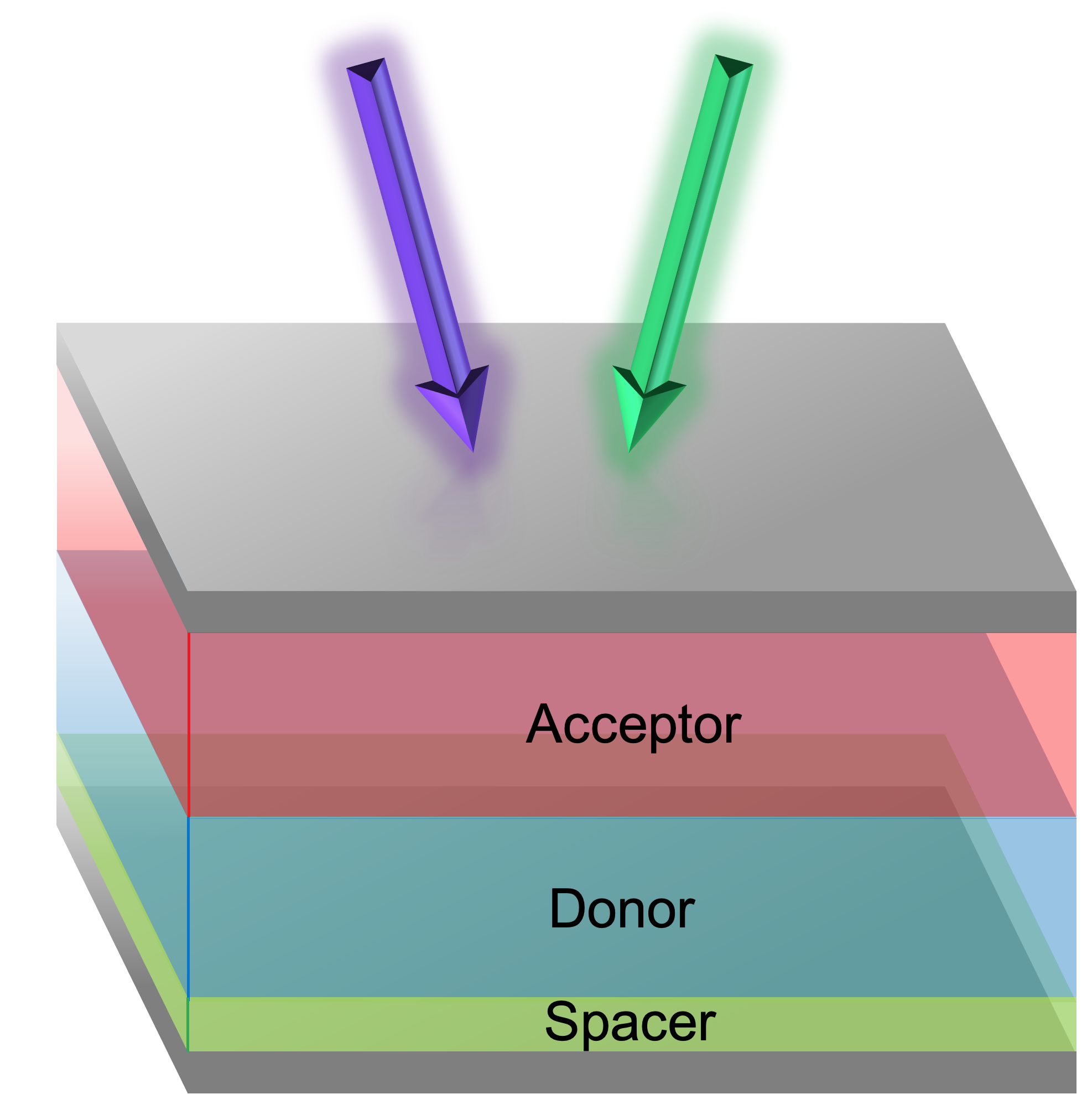
References:
- E. del Valle, A. Gonzalez-Tudela, F. P. Laussy, C. Tejedor, and M. J. Hartmann, Phys. Rev. Lett. 109, 183601 (2012).
- I. Medina, F. J. García-Vidal, A. I. Fernández-Domínguez, and J. Feist, Phys. Rev. Lett. 126, 093601 (2021).
- M. Sánchez-Barquilla, F. J. García-Vidal, A. I. Fernández-Domínguez and J. Feist, Nanophotonics 11(19), 4363-4374 (2022).
Toggle abstract
- Chalmers University of Technology, Sweden
- IFIMAC, Universidad Autónoma de Madrid, Spain
- CSIC, Instituto de Física Fundamental, Madrid, Spain
References:
[1] C. Groiseau, A.I. Fernández-Domínguez, D. Martín-Cano, C.S. Muñoz, PRX Quantum 5, 010312 (2024)Toggle abstract
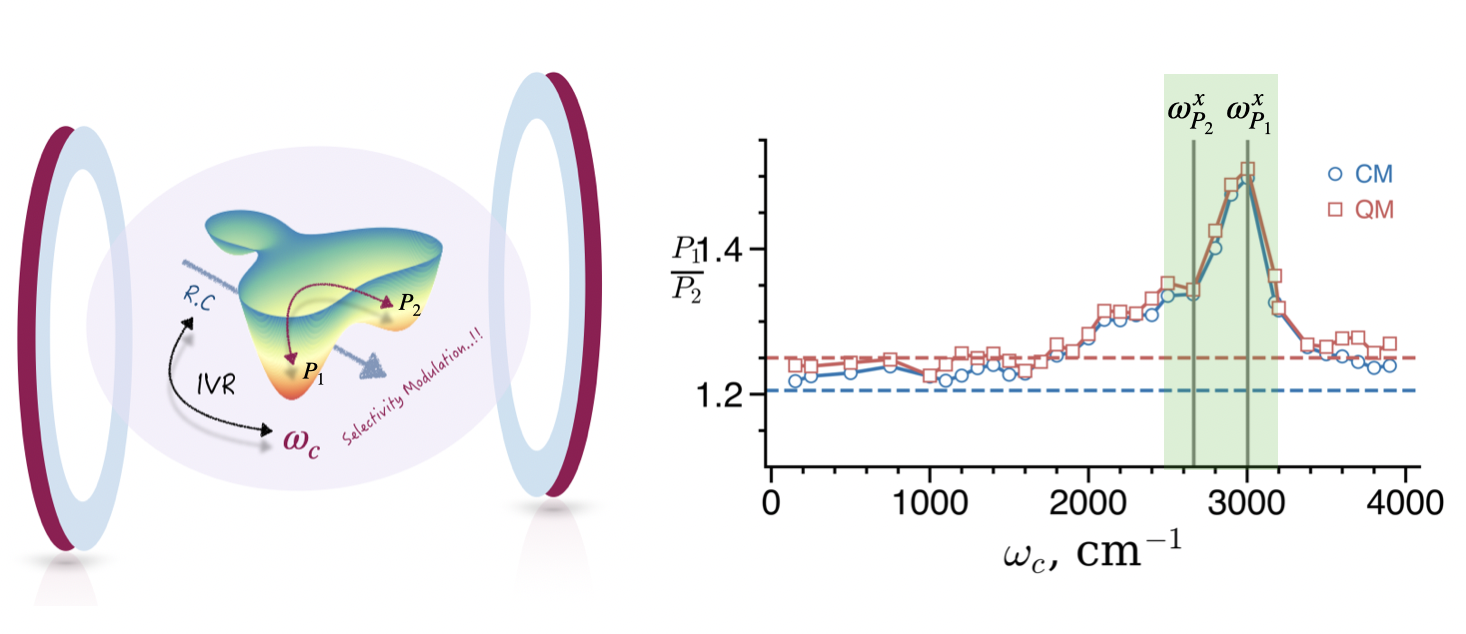
References:
- K. Nagarajan, A. Thomas, T. W. Ebbesen, J. Am. Chem. Soc. 143, 16877 (2021)
- S. Mondal, S. Keshavamurthy, J. Chem. Phys. 161, 244109 (2024)
- S. Mondal, S. Keshavamurthy, J. Chem. Phys. 159, 074106 (2023)
- J. A. Gómez, O. Vendrell, J. Phys. Chem. A 127, 1598 (2023)
- C. Schäfer, J. Flick, E. Ronca, P. Narang, A. Rubio, Nat. Commun. 13, 7817 (2022)
- D. S. Wang, T. Neuman, S. F. Yelin, J. Flick, J. Phys. Chem. Lett. 13, 3317 (2022)
- T. Chen, M. Du, Z. Yang, J. Yuen-Zhou, W. Xiong, Science 378, 790 (2022)
- S. R. Hare, D. J. Tantillo, Pure Appl. Chem. 89, 679 (2017)
- P. Collins, B. K. Carpenter, G. S. Ezra, S. Wiggins, J. Chem. Phys. 139, 154108 (2013)
Toggle abstract
- Department of Chemistry, Indian Institute of Technology Madras, 600036 Chennai, India
- Department of Physics, Indian Institute of Technology Madras, 600036 Chennai, India
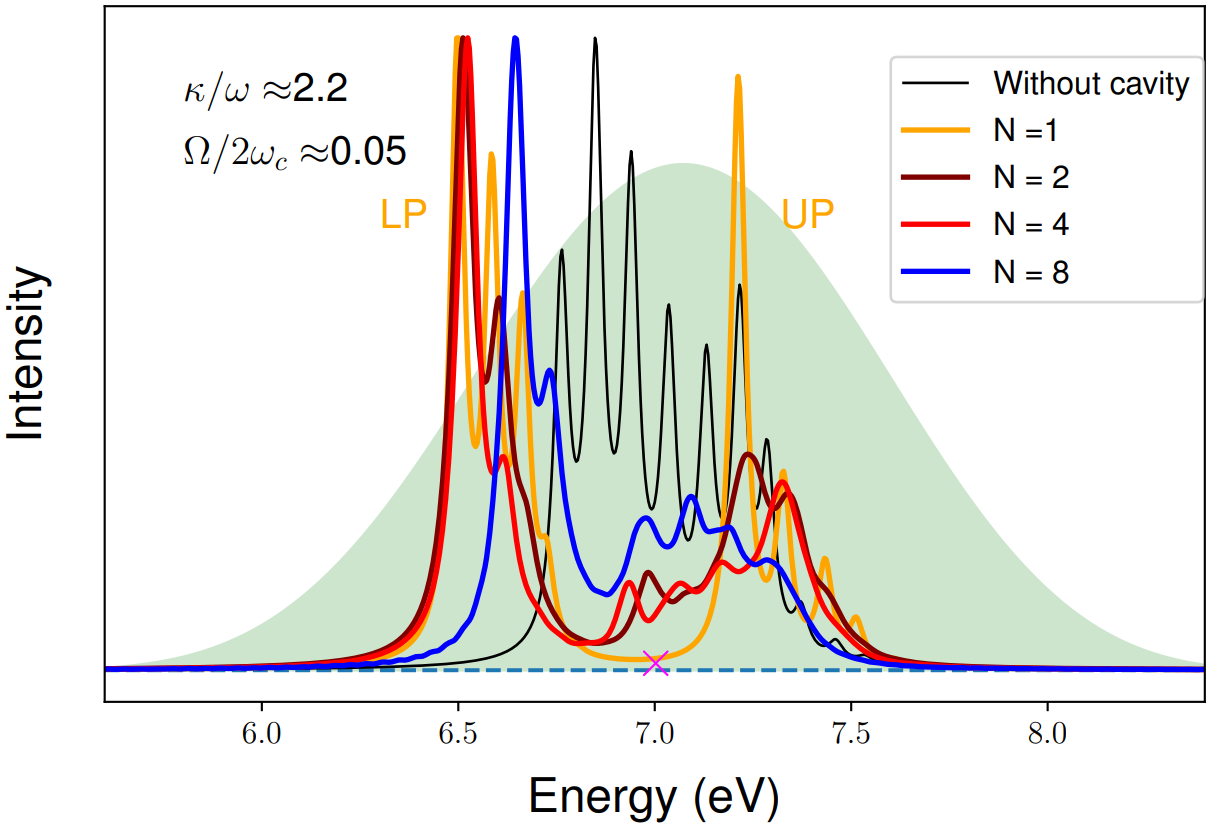
References:
- K. R. Nandipati and O. Vendrell, Phys. Rev. A 107, L061101 (2023).
- S. K. Pandit, A. Pandey, A. Shankar, and K. R. Nandipati, manuscript under preparation.
Toggle abstract
References:
- A. Sandström, H. F. Dam, F. C. Krebs, and L. Edman, Nat. Commun. 3, 1002 (2012).
- A. Sandström, A. Asadpoordarvish, J. Enevold, and L. Edman, Advanced Materials 26, 4975 (2014).
- W. Brütting, J. Frischeisen, T. D. Schmidt, B. J. Scholz, and C. Mayr, Physica Status Solidi (a) 210, 44 (2013).
- L. Novotny and N. Van Hulst, Nat. Phot. 5, 83 (2011).
- M. A. Fusella, R. Saramak, R. Bushati, V. M. Menon, M. S. Weaver, N. J. Thompson, and J. J. Brown, Nature 585, 379 (2020).
Toggle abstract
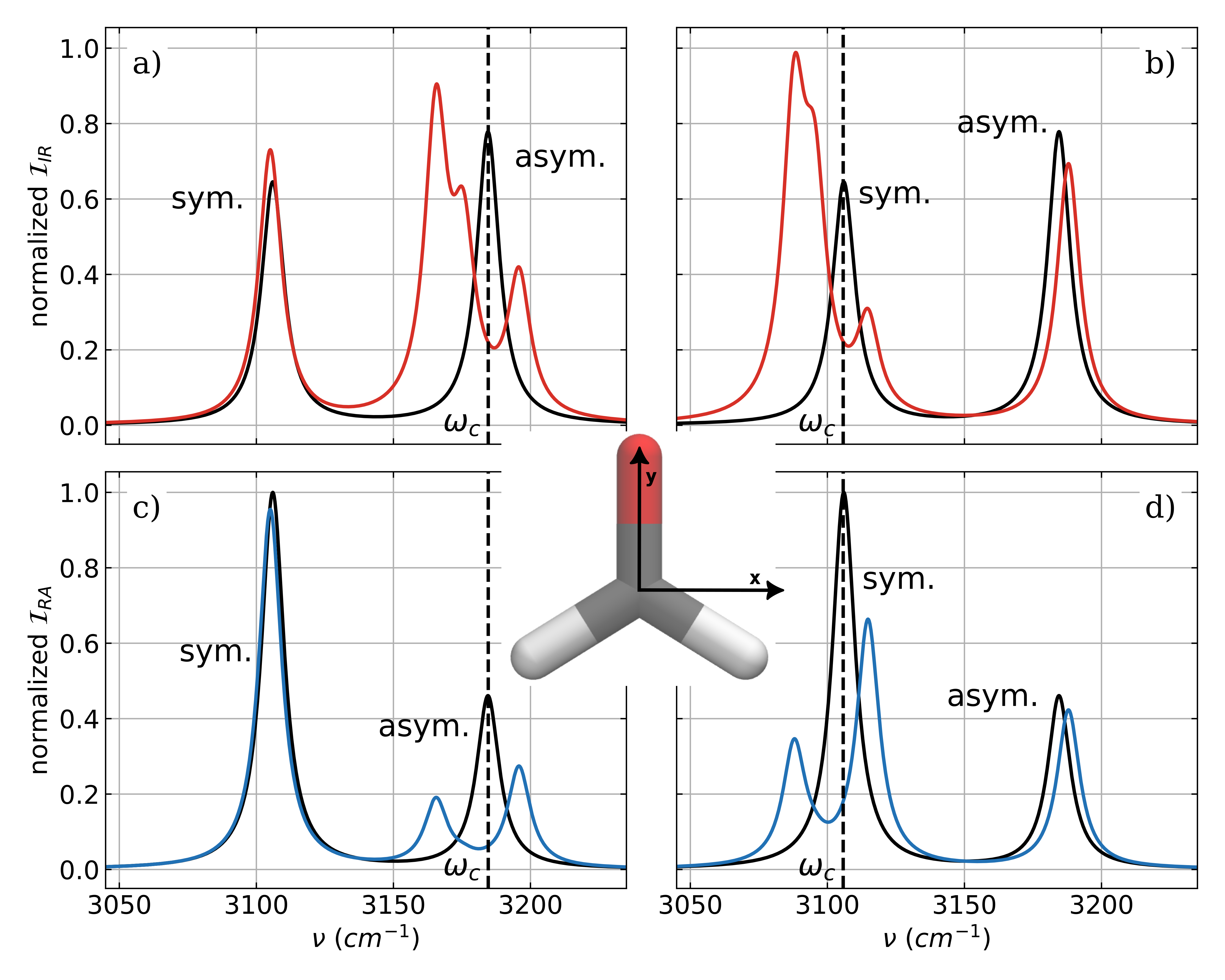
References:
- T. Schnappinger, D. Sidler, M. Ruggenthaler, A. Rubio, M. Kowalewski, J. Phys. Chem. Lett. 14, 8024 (2023).
- T. Schnappinger, M. Kowalewski, J. Chem. Theory Comput. 19, 9278 (2023).
- T. Schnappinger, M. Kowalewski, J. Chem. Theory Comput. 21, 5171 (2025).
- T. Schnappinger, C. Falvo, M. Kowalewski, J. Chem. Phys. 161, 244107 (2024).
Toggle abstract
- Department of Applied Physics, Aalto University School of Science, P.O. Box 15100, Aalto FI-00076, Finland
- Moscow Institute of Physics and Technology, 9 Institutskiy pereulok, Dolgoprudny 141700, Moscow region, Russia
- Center for Integrated Nanotechnologies, Los Alamos National Laboratory, Los Alamos, New Mexico 87545, USA
- Theoretical Division, Los Alamos National Laboratory, Los Alamos, New Mexico 87545, USA
- Department of Chemistry, University of California, Berkeley, California 94720, USA
- Berkeley Center for Quantum Information and Computation, Berkeley, California 94720, USA
- Vienna Center for Quantum Science and Technology (VCQ), Faculty of Physics, University of Vienna, Boltzmanngasse 5, 1090 Vienna, Austria
Toggle abstract
- Departamento de Física Teórica de la Materia Condensada, Universidad Autónoma de Madrid, E-28049 Madrid, Spain
- Condensed Matter Physics Center (IFIMAC), Universidad Autónoma de Madrid, E-28049 Madrid, Spain
- Institute for Theoretical Physics, ETH Zürich, CH-8093 Zürich, Switzerland
Toggle abstract
- Departamento de Física Teórica de la Materia Condensada, Universidad Autónoma de Madrid, E-28049 Madrid, Spain
- Condensed Matter Physics Center (IFIMAC), Universidad Autónoma de Madrid, E-28049 Madrid, Spain
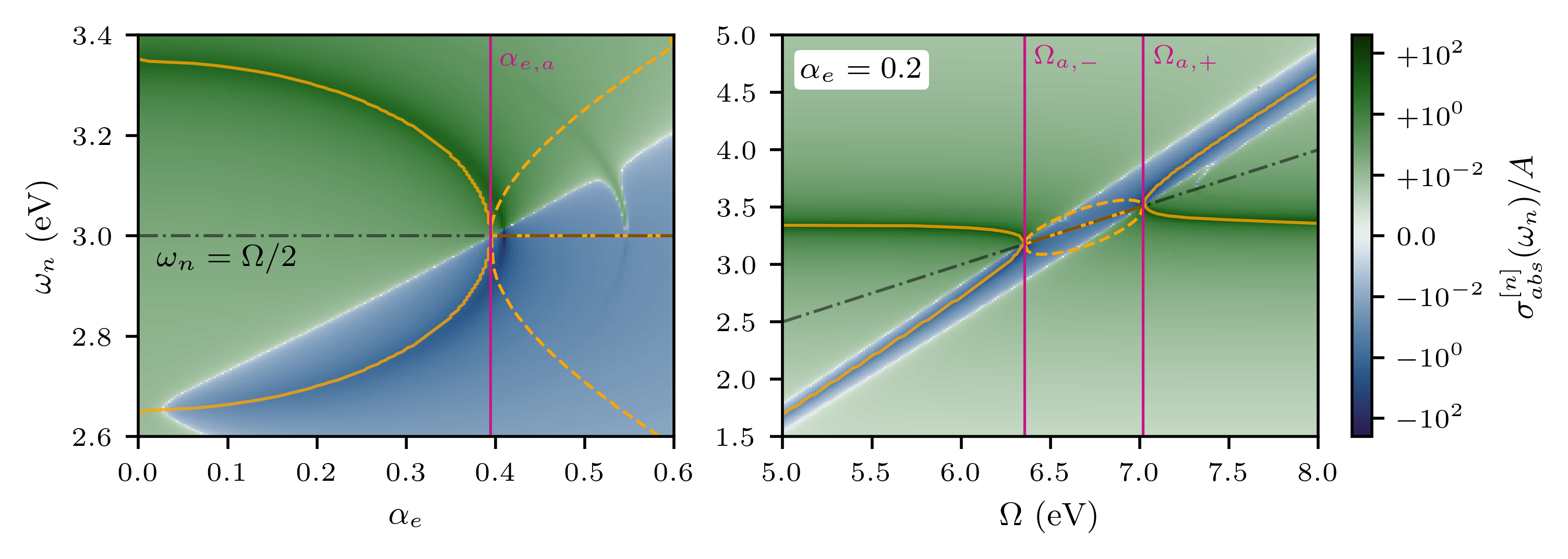
References:
- E. Galiffi, R. Tirole, S. Yin, H. Li, S. Vezzoli, P. A. Huidobro, M. G. Silveirinha, R. Sapienza, A. Alù, and J. B. Pendry, Advanced Photonics, 4, 014002 (2022).
- G. Ptitcyn, A. Lamprianidis, T. Karamanos, V. Asadchy, R. Alaee, M. Müller, M. Albooyeh, M. S. Mirmoosa, S. Fan, S. Tretyakov, and C. Rockstuhl, Laser & Photonics Review, 17(3) (2022)
Toggle abstract
- IfiMAC
- Instituto de Ciencia de Materiales de Madrid (CSIC)

References:
- M. Bello, G. Platero, J.I. Cirac and A. González-Tudela, Science Advances 5, eaaw0297 (2019).
- J. Zurita, C.E. Creffield, G. Platero, Phys. Rev. B 11, 155406 (2025).
 Molecular Polaritonics 2025
Molecular Polaritonics 2025